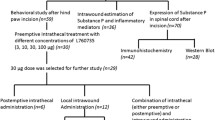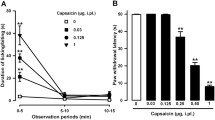Abstract
In anaesthetized rats, the neurokinin (NK)1 receptor antagonist SR140333 (10–1000 μg/kg) stereoselectively inhibited mustard oil-induced plasma protein extravasation in the dorsal skin of the hind paw. After s.c. administration of SR140333, inhibition of plasma protein extravasation was maximal 3 h after injection. A dose of 0.1 mg/kg i.v. or 1.0 mg/kg s.c. produced long-lasting inhibition which was still significant 24 h after treatment.
Since systemic administration of SR140333 has been shown to inhibit nociceptive responses in anaesthetized rats, we wanted to evaluate a possible effect of SR140333 on chemo- and thermonociception in conscious rats. SR140333 (100 μg/kg s.c) did not reduce the behavioral response of rats to the irritant effect of capsaicin in the wiping test, nor did it affect the thermal nociceptive threshold in the plantar test. Furthermore, the decrease in thermal nociceptive threshold which was produced by intraplanter injection of PGE2, and which has been shown to be entirely dependent on capsaicin-sensitive afferents, was not affected by treatment with this NK1 receptor antagonist.
These results show that systemic administration of SR140333, at doses which cause inhibition of neurogenic inflammation, has no detectable effect on acute chemo- or thermonociception in conscious rats.
Similar content being viewed by others
References
Chapman V, Dickenson AH (1993) The effect of intrathecal administration of RP67580, a potent neurokinin-1 antagonist on nociceptive transmission in the rat spinal-cord. Neurosci Lett 157:149–152
De Koninck Y, Henry JL (1991) Substance P-mediated slow excitatory postsynaptic potential elicited in dorsal horn neurons in-vitro by noxious-stimulation. Proc Natl Acad Sci USA 88:1344–1348
Delaygoyet P, Satoh H, Lundberg JM (1992) Relative involvement of substance P and CGRP mechanisms in antidromic vasodilation in the rat skin. Acta Physiol Scand 146:537–538
Edmonds-Alt X, Doutremepuich J-D, Heaulme M, Neliat G; Santucci V, Steinberg R, Vilain P, Bichon D, Ducoux J-P, Proietto V, Van Broeck D, Soubrie P, Le Fur G, Breliere J-C (1993) In vitro and in vivo biological activities of SR140333, a novel potent non-peptide tachkinin NK1 receptor antagonist. Eur J Pharmacol 250:403–413
Eglezos A, Giuliani S, Viti G, Maggi CA (1991) Direct evidence that capsaicin-induced plasma protein extravasation is mediated through tachykinin NK1 receptors. Eur J Pharmacol 209:277–279
Gamse R, Holzer P, Lembeck F (1980) Decrease of substance P in primary afferent neurons and impairment of neurogenic plasma extravasation by capsaicin. Br J Pharmacol 68:207–213
Garret C, Carruette A, Fardin V, Moussaoui S, Peyronel JF, Blanchard JC, Laduron PM (1991) Pharmacological properties of a potent and selective nonpeptide substance-P antagonist. Proc Natl Acad Sci USA 88:208–212
Guard S, Watson S (1991) Tachykinin receptor types: classification and membrane signalling mechanisms. Neurochem Int 18:149–165
Hargreaves K, Dubner R, Brown F, Flores C, Joris J (1988) A new and sensitive method for measuring thermal nociception in cutaneous hyperalgesia. Pain 32:77–88
Holzer P (1991) Capsaicin:Cellular targets, mechanism of action, and selectivity for thin sensory neurons. Pharmacol Rev 43:143–201
Hughes SR, Brain SD (1991) Calcitonin gene-related peptide (CGRP) antagonist (CGRP 8–37) inhibits microvascular responses induced by CGRP and capsaicin in skin. Br J Pharmacol 104:738–742
Jancsó N (1968) Desensitization with capsaicin and related acrylamides as a tool for studying the function of pain receptors. In: Pharmacology of Pain, Proc 3rd Int Pharmacol Meeting. Pergamon Press, Oxford, pp 33–55
Jancsó N, Jancsó-Gábor A Szolcsányi J (1967) Direct evidence for neurogenic inflammation and its prevention by denervation and by pretreatment with capsaicin. Br J Pharmacol Chemother 31:138–151
Jung M, Calassi R, Maruani J, Barnouin MC, Souilhac J, Poncelet M, Gueudet c, Edmonds-Alt X, Soubie P, Breliere JC, LeFur G (1994) Neuropharmacological characterization of SR140333, a non-peptide antagonist of NK1 receptors. Neuropharmacology 33:167–179
Laird JMA, Hargreaves RJ, Hill RG (1993) Effect of RP 67580, a non-peptide neurokinin1 receptor antagonist, on facilitation of a nociceptive spinal flexion reflex in the rat. Br J Pharmacol 109:713–718
Lecci A, Giuliani S, Patacchini R, Viti G, Maggi CA (1991) Role of NK1 tachykinin receptors in thermonociception — effect of (+/−)-CP 96,345, a nonpeptide substance-P antagonist, on the hot plate test in mice. Neurosci Lett 129:299–302
Lei YH, Barnes PJ, Rogers DF (1992) Inhibition of neurogenic plasma exudation in the guinea-pig airways by CP-96,345, a new non-peptide NK(1) receptor antagonist. Br J Pharmacol 105:261–262
Lundberg JM, Saria A (1987) Capsaicin-induced desensitization of the airway mucosa to cigarette smoke, mechanical and chemical irritants. Nature 302:251–253
Malmberg AB, Yaksh TL (1992) Hyperalgesia mediated by spinal glutamate or substance-P receptor blocked by spinal cyclooxygenase inhibition. Science 257:1276–1279
Munro FE, Fleetwood-Walker SM, Parker RMC, Mitchell R (1993) The effects of a neurokinin1 receptor antagonist on mustard oil-evoked activation of rat dorsal horn neurons. Neuropeptides 25:299–305
Sakamoto T, Barnes PJ, Fan Chung K (1993) Effect of CP-96345, a non peptide NK1 receptor antagonist, against substance P, bradykinin- and allergen- induced airway microvascular leakage and bronchoconstriction in the guinea-pig. Eur J Pharmacol 231:31–38
Schuligoi R, Donnerer J, Amann R (1994) Bradykinin-induced sensitization of afferent neurons in the rat paw. Neuroscience 59:211–215
Thompson SWN, Urban L, Dray A (1993) Contribution of NK1 and NK2 receptor activation to high threshold afferent fibre evoked ventral root responses in the rat spinal cord in vitro. Brain Res 625:100–108
Urban L, Thompson SWN, Dray A (1994) Modulation of spinal excitability: co-operation betweeen neurokinin and excitatory amino acid neurotransmitters. Trends Neurosci 17:432–438
Xu X-J, Dalsgaard CJ, Maggi CA, Wiesenfeld-Hallin Z (1992) NK1, but not NK2 tachykinin receptors mediate plasma extravasation induced by antidromic C-fiber stimulation in the rat hindpaw — demonstrated with the NK-1 antagonist CP-96,345 and the NK-2 antagonist MEN-10207. Neurosci Lett 139:249–252
Zimmermann M (1983) Guest editorial. Pain 16:109–110
Author information
Authors and Affiliations
Rights and permissions
About this article
Cite this article
Amann, R., Schuligoi, R., Holzer, P. et al. The non-peptide NK1 receptor antagonist SR140333 produces long-lasting inhibition of neurogenic inflammation, but does not influence acute chemo- or thermonociception in rats. Naunyn-Schmiedeberg's Arch Pharmacol 352, 201–205 (1995). https://doi.org/10.1007/BF00176775
Received:
Accepted:
Issue Date:
DOI: https://doi.org/10.1007/BF00176775




